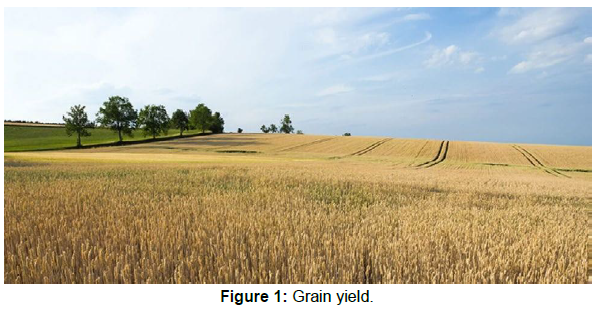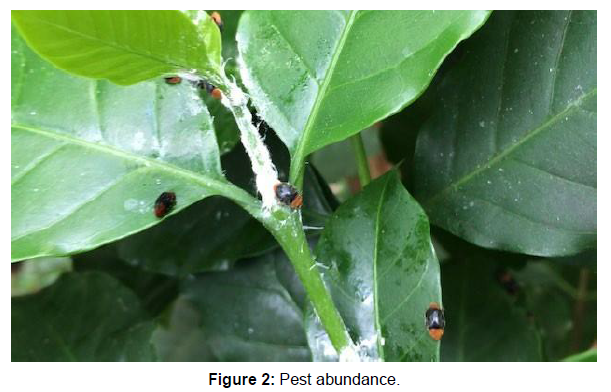Parasitism Rate of Sentinel Pests in Different Treatments in Rice Fields
Received: 01-May-2023 / Manuscript No. RROA-23-99349 / Editor assigned: 04-May-2023 / PreQC No. RROA-23-99349 / Reviewed: 18-May-2023 / QC No. RROA-23-99349 / Revised: 23-May-2023 / Manuscript No. RROA-23-99349 / Published Date: 30-May-2023 DOI: 10.4172/2375-4338.1000361 QI No. / RROA-23-99349
Abstract
Rice is the most important staple food for a large part of the world’s human population, especially in East and South Asia, the Middle East, Latin America, and the West Indies 1 .Globally, rice provides more than one-fifth of the calories consumed by humans. Outbreaks of rice-feeding insect pests are thus a serious threat to food security. Recently, rice yield losses increased due to widespread outbreaks of the brown plant hopper, rice leaf-folder, small brown plant- hopper, rice hispa, yellow stem borer and white-backed plant-hopper. These pests cause hundreds of millions of dollars of losses every year and threaten food security in regions where rice is the staple food. Recent studies have shown that insect pest outbreaks can be traced to the misuse of insecticides threatening the entire rice ecosystem.
Keywords: Southern vietnam; Pesticides; Rice production;Parasitoids; Crop protection; Rice growing period
Keywords
Southern vietnam; Pesticides; Rice production; Parasitoids; Crop protection; Rice growing period
Introduction
Among the key pest of rice, plant-hoppers directly damage plants by sucking the cell sap from the base of the plants. Their feeding also transmits viruses, including rice ragged stunt and rice grassy stunt, which caused the loss of 828,000 tons of rice valued at US$120 million in southern Vietnam in 2005–2006 [1]. Research at Bangladesh Rice Research and the International Rice Research Institute have demonstrated the high costs of plant-hopper outbreaks on rice plantations. Outbreaks of plant-hoppers have been linked to the increased use of broad-spectrum insecticides which cause adverse effects on natural enemies and thus have a negative impact on rice production [2]. In contrast, improved management of rice ecosystems can enhance natural enemies which provide natural control of pest populations. Pesticides are commonly used in food crop production systems to control crop pests and diseases and ensure maximum yield with high market value [3]. However, the accumulation of these chemical inputs in crop fields increases risks to biodiversity and human health. In addition, people are increasingly seeking foods in which pesticide residues are low or absent and that have been produced in a sustainable fashion [4]. More than half of the world’s human population is dependent on rice as a staple food and chemical pesticides to control pests is the dominant paradigm in rice production. In contrast, the use of natural enemies to suppress crop pests has the potential to reduce chemical pesticide inputs in rice production systems [5]. Currently, predators and parasitoids often do not persist in rice production landscapes due to the absence of shelter or nutritional sources. In this study, we modified the existing rice landscape through an eco- engineering technique that aims to increase natural bio-control agents for crop protection [6].
Methodology
In this system, planting nectar-rich flowering plants on rice bunds provides food and shelter to enhance bio-control agent activity and reduce pest numbers, while maintaining grain yield as shown in (Figure 1). The abundance of predators and parasitoids and parasitism rates increased significantly in the eco-engineering plots compared to the insecticide-treated and control plots [7]. Moreover, a significantly lower number of principal insect pests and damage symptoms were found in treatments where flowering plants were grown on bunds than in plots where such plants were not grown. This study indicates that manipulating habitat for natural enemies in rice landscapes enhances pest suppression and maintains equal yields while reducing the need for insecticide use in crop fields. Enhancing existing bio-control agents can also reduce the need for augmenting natural enemies via mass release, reducing expense and risks associated with importing foreign species [8]. Conservation biological control involves modifying the environment or existing practices to protect and enhance natural enemies and reduce pest damage. Habitat management is a form of ecological engineering aimed at providing food and shelter for natural pest control agents. Carefully planned habitat manipulations can increase the abundance and effectiveness of natural enemies while promoting biodiversity and structural complexity of agro-ecosystems.
Discussion
In particular, providing natural enemies with needed resources such as nectar, pollen, physical refugia, alternative prey, alternative hosts and lekking sites. The concept of ecological engineering has been used to restore or enhance biodiversity in the rice land-scape [9]. Unlike many flowering plants, rice lacks floral or extra-floral nectar resources that can be used by natural enemies. Planting additional nectar-rich flowering crops in rice landscapes can enhance year-round resource for natural enemies. In Bangladesh, individual rice fields are typically surrounded by an earthen ridge approximately 0.5 m in height to retain irrigation water. These ridges are commonly known as a rice bund or ail and are typically fallow throughout the year [10]. Under eco- agricultural management, bunds are enriched with nectar producing plants and non-rice habitats used to grow perennial plants to provide additional food and shelter for natural enemies. These improved habitat-characteristics can greatly influence natural enemy longevity, fecundity and behaviour and lead to reduced pest abundance as shown in (Figure 2).
The main goal of this study was to test the efficacy of an eco- agricultural system in promoting natural enemies, reducing crop pests and maintaining rice yield [11]. We contrasted three treatments; growing nectar-rich plants on bunds coupled with no insecticides on rice, compared to fallow bunds with, and without prophylactic insecticide use on rice. Insect pests and natural enemies observed during the three Boro seasons. The results show that the highest number of grasshoppers and yellow stem borers were found in T3. A significantly lower number of GHs was found in the T1 treatment. Other insect pests were not observed and are not presented here. The green mirid bug is the most important predator of brown plant-hoppers in rice fields [12]. Populations of GMBs were observed in only the T1 treatment. In subsequent years, significantly higher numbers of natural enemies, including spiders, damsel flies, and lady bird beetles were found in T 1 than in the other treatments. We also recorded parasitoids of rice insect pests using yellow sticky traps [13]. The highest number of parasitoids was observed in the T 1 treatment plots during the Boro season in and traps facing east and west in each field caught similar numbers of parasitoids. Grasshoppers were more abundant in the T 1 treatment, but remained below the economic threshold level and a similar pattern was observed in 2017 [14]. However, grasshoppers generally do not hamper successful rice production and are seldom treated in the absence of other key pests. In 2017, abundance of a key economic insect pest, the green leafhopper was lower in T 1 than the control treatment. In 2016, parasitoids, spiders and damsel flies were more abundant in T 1 but not in 2017. Parasitism of key pests, brown plant-hopper, white-backed plant-hopper, rice hispa and yellow stem borer and also differed among treatments. In all cases parasitism of pest eggs was significantly higher in T 1 than in other treatments Parasitism of plant-hopper eggs was higher in the T. Aman season, exceeding 80% than in the Boro season when it never exceeded 60%.
Conclusion
The presence of flowering plants on rice bunds had a significant impact on the damage intensity caused by YSBs. The highest incidence of white head per 100 hills due to YSB infestation was found in T 2 plots, where insecticide was applied three times during the rice growing period. The lowest incidence of white head was in the T1 plots, which were not sprayed with insecticide and bordered by sesame/marigold/ cosmos.
Acknowledgement
None
Conflict of Interest
None
References
- Lado C (1990)Informal urban agriculture in Nairobi, Kenya: problem or resource in development and land use planning? .Land use policy EU 7:257-266.
- Senthilkumar K, Bindraban PS, Thiyagarajan TM, Ridder ND, Giller KE (2008) Modified rice cultivation in Tamil Nadu, India: yield gains and farmers'(lack of) acceptance. Agric Syst UK 98:82-94.
- Kumar V, Ladha JK (2011) Direct Seeding of Rice: Recent Developments and Future Research Needs. Adv Agron US 111:297-413.
- Kotera A, Sakamoto T, Nguyen DK, Yokozawa M (2008) Regional consequences of seawater intrusion on rice productivity and land use in coastal area of the Mekong River Delta. Agric Environ 42:267-274.
- Pingali PL, Xuan VT (1992) Vietnam: Decollectivization and rice productivity growth. EDCC US 40:697-718.
- Rugumamu CP (2014) Empowering smallholder rice farmers in Tanzania to increase productivity for promoting food security in Eastern and Southern Africa. Agric Food Secur NY1-8.
- Emmanuel D, Enoch OS, Victor O, Henry J (2016) Impact of row-planting adoption on productivity of rice farming in Northern Ghana. RAAE EU 19 :19-28
- Easter KW, Abel ME, Norton G (1977) Regional Differences in Agricultural Productivity in Selected Areas of India. Am J Agric Econ 59:257-265.
- Wassmann R, Jagadish SVK, Heuer S, Ismail A, Redona E, et al. (2009) Climate Change Affecting Rice Production: The Physiological and Agronomic Basis for Possible Adaptation Strategies. Adv Agron US 101:59-122.
- Farooq MD, Usman MD, Nadeem F, Rehman HU, Wahid A, et al. (2019) Seed priming in field crops: Potential benefits, adoption and challenges. Crop Pasture Sci AU 70:731-771.
- Drechsel P, Dongus S (2009) Dynamics and sustainability of urban agriculture: Examples from sub-Saharan Africa. Sustain Sci UN 5: 69-78.
- Smit J, Nasr J (1992) Urban agriculture for sustainable cities: using wastes and idle land and water bodies as resources. Environ Urban US 4:141-152.
- Mark S J, Michael J L, Thoreau R T, Nicholas C (2015) Attenuation of urban agricultural production potential and crop water footprint due to shading from buildings and trees. Environ Res Lett UK 10:1-12.
- Karanja NN, Njenga M, Prain G, Kangâethe E, Kironchi G,et al. (2010)Assessment of environmental and public health hazards in wastewater used for urban agriculture in Nairobi, Kenya. Trop Subtrop Agroecosystems USA 12:85-97.
Indexed at, Google Scholar, Crossref
Indexed at, Google Scholar, Crossref
Indexed at, Google Scholar, Crossref
Indexed at, Google Scholar, Crossref
Indexed at, Google Scholar, Cross Ref
Indexed at, Google Scholar, Crossref
Indexed at, Google Scholar, Crossref
Indexed at, Google Scholar, Crossref
Indexed at, Google Scholar, Crossref
Indexed at, Google Scholar, Crossref
Indexed at, Google Scholar, Crossref
Indexed at, Google Scholar, Crossref
Citation: Gaballah Md (2023) Parasitism Rate of Sentinel Pests in Different Treatments in Rice Fields. J Rice Res 11: 361. DOI: 10.4172/2375-4338.1000361
Copyright: © 2023 Gaballah Md. This is an open-access article distributed under the terms of the Creative Commons Attribution License, which permits unrestricted use, distribution, and reproduction in any medium, provided the original author and source are credited.
Share This Article
Recommended Journals
Open Access Journals
Article Tools
Article Usage
- Total views: 809
- [From(publication date): 0-2023 - Apr 01, 2025]
- Breakdown by view type
- HTML page views: 590
- PDF downloads: 219


